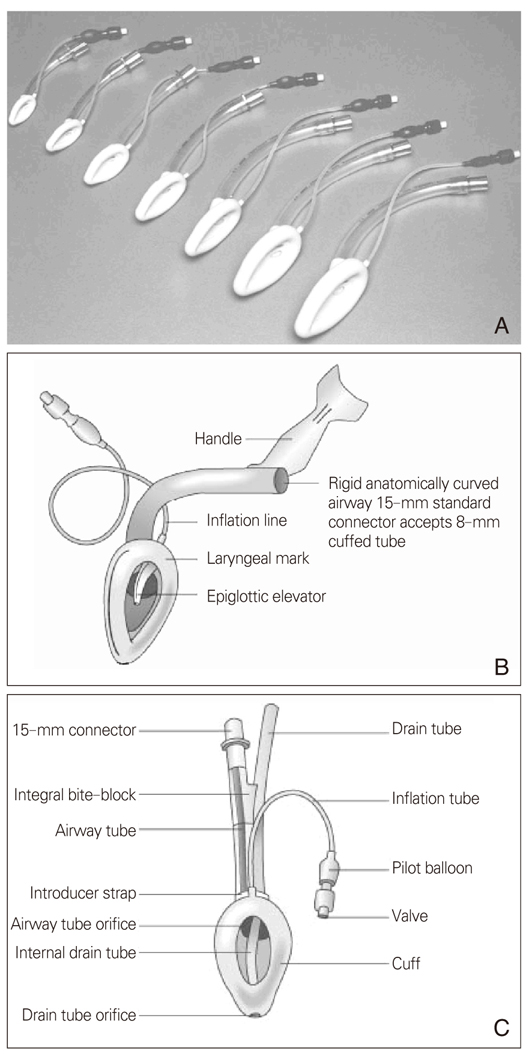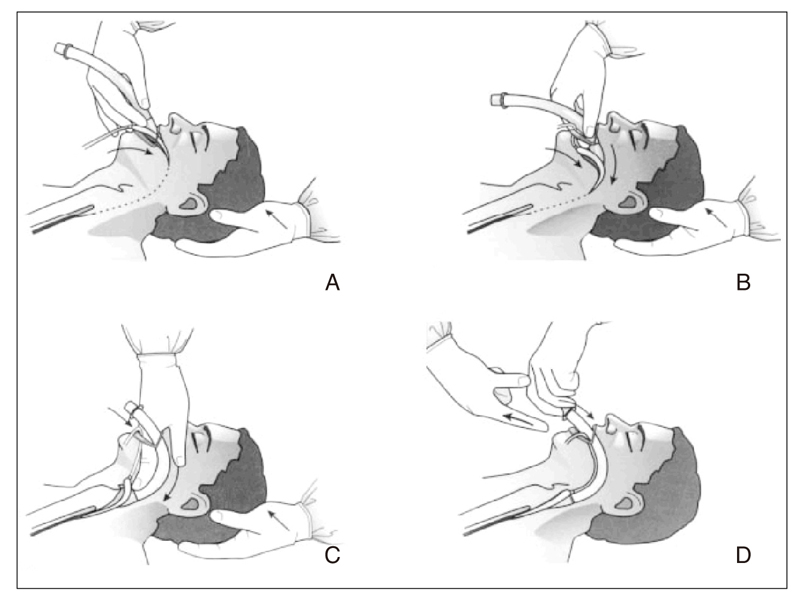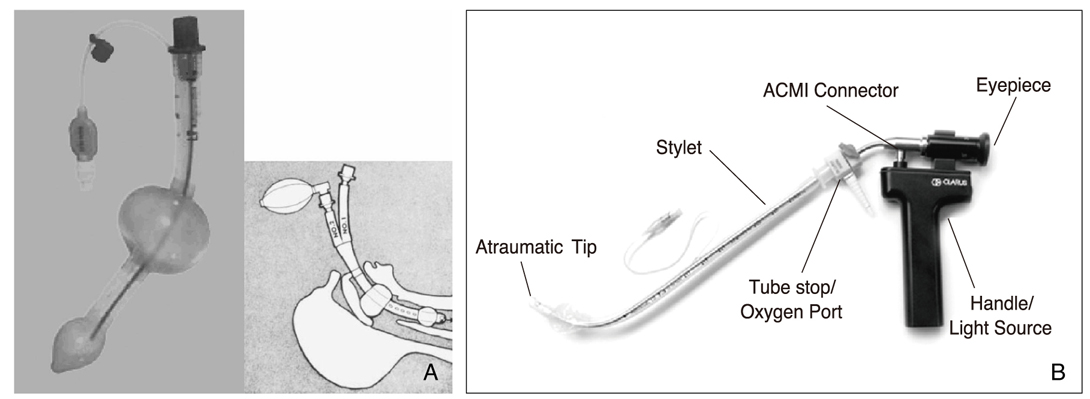J Korean Med Assoc.
2007 Dec;50(12):1048-1056. 10.5124/jkma.2007.50.12.1048.
Airway Management
- Affiliations
-
- 1Department of Anesthesiology and Pain Medicine, Kyungpook National University College of Medicine. sokim@knu.ac.kr
- KMID: 2184952
- DOI: http://doi.org/10.5124/jkma.2007.50.12.1048
Abstract
- Airway management is still perceived as the greatest patient safety issue and the key task that anesthesiologists perform. Management includes mask ventilation, use of a laryngoscope, and the endotracheal intubation and extubation of the patient. Difficulty can be encountered at any of these stages, and can be a major cause of anesthesia-related morbidity and mortality. Competence in airway management requires knowledge of the anatomy and physiology of the airway, ability to access the patient's airway for the anatomic features that correlate with difficulties in airway management, skill with the many devices used in airway management, including a variety of recently-introduced airway tools, and the appropriate application of the sophisticated algorithm for difficult airway management. Development and clinical distribution of supraglottic airway devices and their enhancement, as well as the broad acceptance of awake fiber-optic intubation, has led to profound changes in the strategy for managing a difficult airway. Including the American Society of Anesthesiologists, many countries have developed their own airway management algorithm these days. Nevertheless, massive national and international deficits still exist in implementing these guidelines into practice as well as the implicated structural requirements with respect to education, reflection, team building and equipment concerning each individual institution. In regard to this situation, it is the recommendation of the author that our country develop and institute such a standardized system of airway management.
Keyword
MeSH Terms
Figure
Reference
-
1. Henderson JJ, Popat MT, Latto IP, Pearce AC. Difficult Airway Society guidelines for management of the unanticipated difficult intubation. Anaesthesia. 2004. 59:675–694.2. Caplan RA, Posner KL, Ward RJ, Cheney FW. Adverse respiratory events in anesthesia: A closed claims analysis. Anesthesiology. 1990. 72:828–833.
Article3. American Society of Anesthesiologists Task Force on Management of the Difficult Airway. Practice guidelines for management of the difficult airway: an updated report by the American Society of Anesthesiologists Task Force on Management of the Difficult Airway. Anesthesiology. 2003. 98:1269–1277.4. Rocke DA, Murray WB, Rout CC, Gouws E. Relative risk analysis of factors associated with difficult intubation in obstetric anesthesia. Anesthesiology. 1992. 77:67–73.
Article5. Mallampati SR, Gatt SP, Gugino LD, Desai SP, Waraksa B, Freiberger D, Liu PL. A clinical sign to predict difficult tracheal intubation: a prospective study. Can J Anaesth. 1985. 32:429–434.
Article6. Langeron O, Masso E, Huraux C, Guggiari M, Bianchi A, Coriat P, Riou B. Prediction of difficult mask ventilation. Anesthesiology. 2000. 92:1229–1236.
Article7. Rose DK, Cohen MM. The airway: problems and predictions in 18,500 patients. Can J Anaesth. 1994. 41:372–383.
Article8. Williamson JA, Webb RK, Szekely S, Gillies ER, Dreosti AV. Difficult intubation: an analysis of 2000 incident reports. Anaesth Intensive Care. 1993. 21:602–607.
Article9. Yildiz TS, Solak M, Toker K. Comparison of laryngeal tube with laryngeal mask airway in anaesthetized and paralysed patients. Eur J Anaesthesiol. 2007. 24:620–625.
Article10. Joshi GP, Inagaki Y, White PF, Taylor-Kennedy L, Wat LI, Gevirtz C, McCraney JM, McCulloch DA. Use of the laryngeal mask airway as an alternative to the tracheal tube during ambulatory anesthesia. Anesth Analg. 1997. 85:573–577.
Article11. Parmet JL, Colonna-Romano P, Horrow JC, Miller F, Gonzales J, Rosenberg H. The laryngeal mask airway reliably provides rescue ventilation in cases of unanticipated difficult tracheal intubation along with difficult mask ventilation. Anesth Analg. 1998. 87:661–665.
Article12. Cormack RS, Lehane J. Difficult tracheal intubation in obstetrics. Anaesthesia. 1984. 39:1105–1111.
Article13. Knill RL. Difficult laryngoscopy made easy with a BURP. Can J Anaesth. 1992. 40:279–282.
Article14. Adnet F, Borron SW, Lapostolle F, Lapandry C. The three axis alignment theory and the sniffing position: perpetuation of an anatomic myth? Anesthesiology. 1999. 91:1964–1965.
Article15. Chou HC, Wu TL. A reconsideration of the three axes alignment theory and sniffing position. Anesthesiology. 2002. 97:753–754.16. Adnet F, Baillard C, Borron SW, Denantes C, Lefebvre L, Galinski M, Martinez C, Cupa M, Lapostolle F. Randomized study comparing the sniffing position with simple head extension for laryngoscopic view in elective surgery patients. Anesthesiology. 2001. 95:836–841.
Article17. Mercer MH, Gabbott DA. Insertion of the Combitube airway with the cervical spine immobilized in a rigid cervical collar. Anaesthesia. 1998. 53:971–974.
Article18. Agrò F, Hung OR, Cataldo R, Carassiti M, Gherardi S. Lightwand intubation using the Trachlight. Can J Anaesth. 2001. 48:592–599.19. Ferson DZ, Rosenblatt WH, Johansen MJ, Osborn I, Ovassapian A. Use of the Intubating LMA-Fastrach in 254 patients with difficult-to-manage airways. Anesthesiology. 2001. 95:1175–1181.
Article20. Benemof JL. Management of the difficult adult airway with special emphasis on awake tracheal intubation. Anesthesiology. 1991. 75:1087–1110.
Article21. Henderson JJ, Popat MT, Latto IP, Pearce AC. Difficult Airway Society. Difficult Airway Society guidelines for management of the unanticipated difficult intubation. Anaesthesia. 2004. 59:675–694.22. Asai T, Koga K, Vaughan RS. Respiratory complications associated with tracheal intubation and extubation. Br J Anaesth. 1998. 80:767–775.
Article23. Barron FA, Ball DR, Jefferson P, Norrie J. 'Airway Alerts' How UK anaesthetists organize, document and communicate difficult airway management. Anaesthesia. 2003. 58:73–77.
Article24. Kerridge RK, Crittenden MB, Vutukuri VL. A multiple-hospital anaesthetic problem register: establishment of a regionally organized system for facilitated reporting of potentially recurring anaesthetic-related problems. Anaesth Intensive Care. 2001. 29:106.
Article25. Rosenblatt WH, Wagner PJ, Ovassapian A, Kain ZN. Practice patterns in managing the difficult airway by anesthesiologists in the United States. Anesth Analg. 1998. 87:153–157.
Article
- Full Text Links
- Actions
-
Cited
- CITED
-
- Close
- Share
- Similar articles
-
- A comprehensive review of difficult airway management strategies for patient safety
- Updated review in pediatric airway management
- Airway management using O2 flush via Cook airway exchange catheter(R) for microlaryngeal surgery
- Evolution of Asthma Concept and Effect of Current Asthma Management Guidelines
- Post-radiation airway management - An anesthesiologist's challenge






